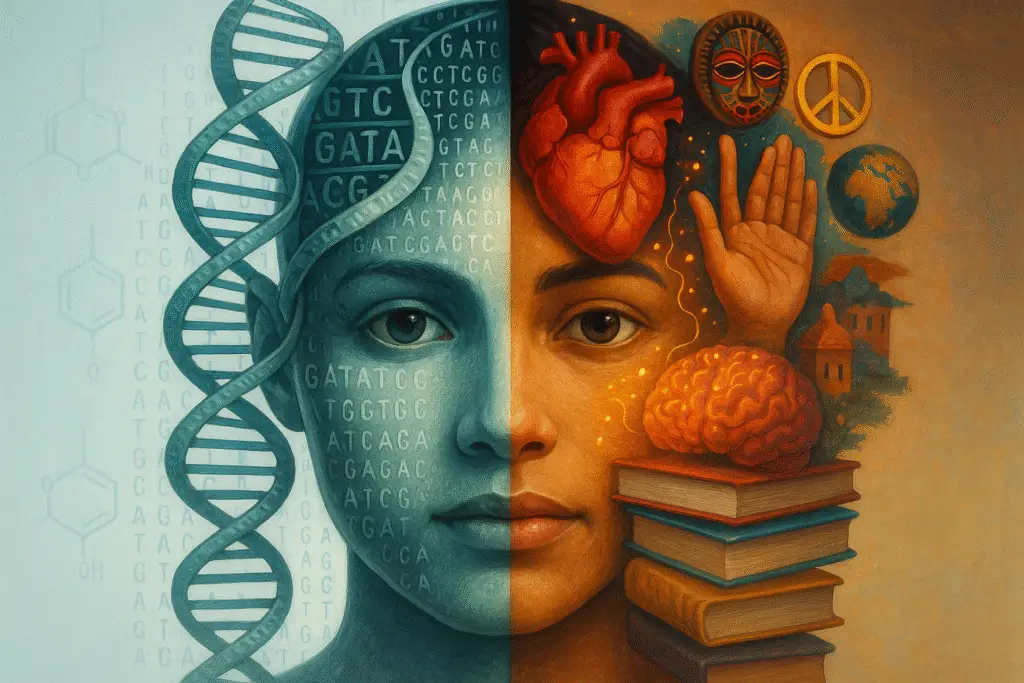No, Allergies are not just random immune glitches. They are often written in our DNA as a result of both inherited genes and environmental exposure. In other words, it results from the complex interaction between genes and the environment.
We all know someone who cannot even eat a single peanut, or someone who starts sneezing uncontrollably as soon as spring arrives. However, we never considered the genetic origins of allergic responses.
You might have always wondered, Why do only some people have allergies while others don’t?
Don’t worry, in this article, you will find the answer to every question you have in mind about allergies.
In this article, we will explore the genetic architecture of allergies.
Related article: How Does Air Pollution Affect Our Genetics?
Key Topics:
What is an allergy?
Allergies occur when our body generates an immune reaction against a foreign substance that enters our body by inhalation, ingestion or skin penetration. These substances are known as allergens. Allergies are hypersensitive immune responses to these allergens.
These allergens can include pollen, food, dust, pet dander, or even some medications. These substances are usually harmless, but they can trigger an immediate immune response in some. And that is where the genetics and DNA come into play.
The most common allergic diseases include the following: allergic rhinitis (AR), often diagnosed together with atopic asthma (AA); atopic dermatitis (AD), as well as inhalatory allergy (IA); contact allergy (CA); and food allergy (FA).
When someone with an allergy is exposed to that specific allergen, their immune system reacts by producing the antibodies that lead to various symptoms that can be mild to sometimes even life-threatening reactions (anaphylaxis).
Let us first understand the immune mechanism of allergies, and then we can look at the genetic part.
Related article: How Do You Know If You Have Good Genetics [In General].
Allergies and the immune system:
The purpose of the immune system is to defend itself and keep microorganisms, such as certain bacteria, viruses, and fungi, out of the body, and to destroy any infectious microorganisms that do invade the body.
Our immune system protects our body from infection and allergies, which is a complex network of proteins, cells and organs.
Allergens cause an allergic reaction. In response to these allergens, our immune system reacts by generating a Type 1 hypersensitivity response, which is mediated by IgE antibodies (immunoglobulin E).
When a person is first exposed to an allergen, the antigen-presenting cells process that allergen and present it to the naive T-helper cells. If the person is allergic to this specific allergen, these naive T-helper cells differentiate into Th2 cells, which stimulate B-cells to produce the IgE antibodies.
Now these IgE antibodies bind to mast cells and basophils via the receptor that sensitises the immune system, which, upon subsequent exposures to these allergens, triggers degranulation. This releases histamine, leukotrienes, and cytokines, which lead to symptoms like itching, sneezing, rashes, or even anaphylaxis.
Now let’s further understand where genetics comes in……
Related article: How Caffeine Consumption is Hurting Your DNA.
Allergies and genetics:
Studies prove that if one parent has an allergy, the child is 30-50% at risk of developing one too. The risk increases to 60-80% if both parents are allergic. So yes, allergies can be inherited.
As we discussed, environmental factors trigger the allergy and then the whole immune response against it. Interestingly, the lesser-known fact is that our DNA and genes dictate this response. Thus, specific genes influence the entire cascade of reactions.
IL13, IL4 and IL4RA are key genes that regulate the Th2 immune response, crucial for the production of IgE antibodies. Any variations in these genes can lead to abnormal allergic responses.
Another important gene is FCER1A, which encodes the affinity receptor for IgE found on mast cells; a mutation in this gene can increase mast cell activation, resulting in a stronger allergic reaction even if the allergen is in a tiny amount.
HLA class 2 genes help in determining how the immune system recognises allergens, and influence the severity and type of allergy a person may experience.
Additionally, loss-of-function mutations in the gene coding for filaggrin (FLG) are the cause of ichthyosis vulgaris, marking a significant breakthrough in understanding the pathogenesis of allergic diseases.
The mutation in this gene impairs the skin’s barrier, which increases the risk. Studies show that 50% of eczema patients have this mutation.
A recent study published in the journal Wiley used genome-wide association studies (GWAS) to explore how our DNA can predispose us to allergic conditions, identifying various genes that are responsible for conditions like allergic rhinitis, atopic dermatitis, and food allergies.
The study also emphasises that genetic variants often influence multiple allergic diseases at once. This means that if someone carries these variants, they’re genetically more sensitive to allergens.
Wrapping up:
Now you know that allergies are not just a reaction to the environmental triggers; our DNA also plays a major role here. It helps us understand why some people suffer from allergies while others do not.
I hope you like this article. Share it and subscribe to Genetic Education.
Resources:
- Ogrodowczyk, Anna, et al. “Mutations in the Filaggrin Gene and Food Allergy.” Gastroenterology Review, vol. 4, 2014, pp. 200–207, https://doi.org/10.5114/pg.2014.45100.
- Portelli, M. A., et al. “Genetic Risk Factors for the Development of Allergic Disease Identified by Genome-Wide Association.” Clinical & Experimental Allergy, vol. 45, no. 1, 26 Dec. 2014, pp. 21–31, https://doi.org/10.1111/cea.12327.


